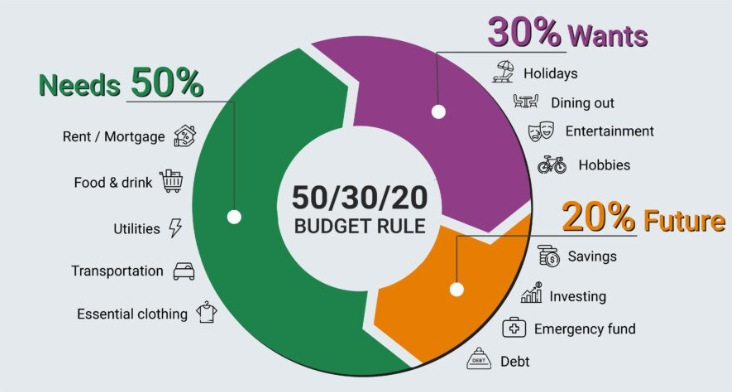The 50/30/20 Rule Explained: How to Budget Without Overthinking
If the word budget makes you picture spreadsheets, endless receipts, and late-night math sessions, you’re not alone. Many people think managing money has to be complicated. But it doesn’t.
Enter the 50/30/20 Rule a straightforward budgeting framework that helps you spend wisely, save consistently, and avoid financial stress. No complicated formulas. No obsessive tracking. Just three numbers.
What Is the 50/30/20 Rule?
The 50/30/20 Rule is a money management method popularized by U.S. Senator Elizabeth Warren in her book All Your Worth: The Ultimate Lifetime Money Plan. It divides your after-tax income into three simple categories:
-
50% – Needs
Essential expenses you can’t avoid, such as:-
Rent or mortgage
-
Utilities (electricity, water, internet)
-
Groceries
-
Transportation
-
Minimum debt payments
-
Insurance
-
-
30% – Wants
Things that make life more enjoyable but aren’t essential, such as:-
Dining out
-
Vacations
-
Streaming subscriptions
-
Shopping for clothes beyond necessities
-
Hobbies and entertainment
-
-
20% – Savings & Debt Repayment
Your financial future and security:-
Emergency fund contributions
-
Retirement savings (401k, IRA, pension)
-
Extra debt payments (above the minimum)
-
Investments
-
Why It Works
The genius of the 50/30/20 Rule is its simplicity:
-
You only need to track three spending buckets.
-
It’s flexible you can adjust slightly if your lifestyle or location demands it.
-
It ensures you’re not neglecting savings while still enjoying life.
Example: 50/30/20 in Action
Let’s say your after-tax income is $3,000/month:
-
Needs (50%) → $1,500
-
Wants (30%) → $900
-
Savings/Debt Repayment (20%) → $600
This gives you a quick blueprint for where your money should go without having to account for every single coffee you buy.
Tips to Make It Work for You
-
Start with your real numbers – Track your spending for one month to see where your money goes.
-
Adjust for your reality – If you live somewhere with high rent, your needs might be 60% and wants 20%.
-
Automate savings – Set up automatic transfers so you don’t have to rely on willpower.
-
Review quarterly – Life changes, so revisit your budget every few months.
The Bottom Line
The 50/30/20 Rule isn’t about restriction it’s about clarity and balance. It helps you cover essentials, enjoy life now, and still prepare for the future, all without feeling like budgeting is a second job.
If you’ve been avoiding budgeting because it feels overwhelming, this might be your perfect starting point. After all, the best budget is the one you’ll actually stick to.


